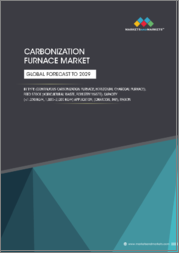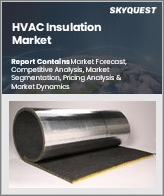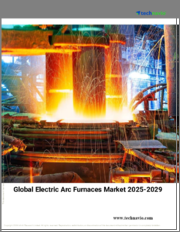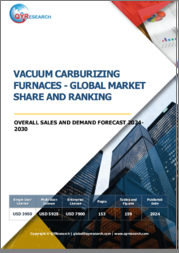
|
시장보고서
상품코드
1516919
세계의 탄화로 시장 : 유형별, 원료별, 처리능력별, 용도별, 지역별 예측(-2029년)Carbonization Furnace Market by Type (Countinous carbonization furnace), Feed Stock (Agricultural waste, Forestry Waste, Nutshell waste), Capacity (<1000 kg/h, 1000-2000 kg/h) Application (Charcoal, Wood Vinegar, Tar), Region - Global Forecast to 2029 |
||||||
세계의 탄화로 시장 규모는 2024년 2억 6,300만 달러에서 2029년까지 4억 2,500만 달러에 이를 것으로 예측되며, 예측 기간에 CAGR로 10.1%의 성장이 예상됩니다.
시장의 성장과 진화에는 다양한 변수가 기여하고 있습니다. 주요 촉진요인 중 하나는 세계적인 지속가능성과 환경보호에 대한 관심 증가입니다. 기후 변화와 탄소 배출에 대한 우려가 커지고 있는 가운데 산업과 정부는 환경 실적를 줄이면서 탄소 격리를 증가시키는 솔루션을 적극적으로 모색하고 있습니다. 탄화로, 특히 바이오차과 목탄 생성에 사용되는 탄화로는 이러한 노력에 필수적입니다. 이 퍼니스는 바이오매스를 안정된 탄소 형태로 바꾸어 탄소 회수 및 저장에 기여하여 온실가스의 영향을 줄입니다.
| 조사 범위 | |
|---|---|
| 조사 대상년도 | 2020-2029년 |
| 기준년 | 2023년 |
| 예측 기간 | 2024-2029년 |
| 단위 | 10억/100만 달러 |
| 부문 | 유형, 원료, 용도, 처리 능력, 지역 |
| 대상 지역 | 아시아태평양, 북미, 유럽, 중동, 아프리카, 남미 |
"임업 폐기물이 시장 원료 부문에서 금액 기준으로 가장 큰 점유율을 차지했습니다."
임업 폐기물 원료는 그 양, 비용 효과, 환경적 이점으로부터 탄화로 시장을 독점하고 있습니다. 벌목과 산림 관리와 같은 임업 활동은 가지, 나무 껍질, 톱밥, 목재 칩을 포함한 많은 양의 잔류 바이오 매스를 생산합니다. 일반적으로 폐기물로 분류되는 이 바이오매스는 탄화로의 원료로 널리 이용 가능하고 저렴합니다. 임업 폐기물을 이용함으로써, 본래라면 환경 부하가 될 것을 바이오차이나 목탄의 제조에 이용하는 수익성이 높은 자원으로 변환함으로써, 쓰레기 처리 문제를 해결할 수 있다 합니다.
임업 폐기물을 이용함으로써 환경상의 이점은 매우 큽니다. 이 바이오매스를 바이오차이나 목탄으로 변환함으로써 온실가스의 배출이나 기후 변화의 원인이 되는 분해나 연소시에 배출되는 탄소가 격리됩니다. 임업 폐기물에서 생산되는 바이오차는 탄소 격리에 도움이 되고 세계의 탄소 감축 목표를 지원하며 토양 개량재로 활용되면 토양의 건전성을 높입니다. 이 두 가지 환경상의 이점으로 인해 임업 폐기물은 매우 매력적인 원료가되었습니다.
"시장 용도 부문에서 목탄은 금액 기준으로 최대 점유율을 차지했습니다."
다양한 설득력 있는 이유로 목탄 용도가 시장을 독점하고 있습니다. 첫째, 목탄은 세계의 많은 지역, 특히 현대적인 에너지원에 대한 접근이 제한된 개발도상국에서 여전히 중요하고 자주 사용되는 연료원입니다. 목탄은 요리, 난방 및 산업 활동에 널리 사용되며 수백만 명의 가정과 기업에 신뢰할 수 있고 비용 효율적인 에너지 원을 제공합니다. 이러한 에너지원으로서의 목탄에 대한 지속적인 수요가 목탄 생산 전용의 탄화로 시장을 견인하고 있습니다. 게다가 목탄의 적응성과 폭넓은 용도가 세계적인 우위성을 높이고 있습니다. 연료로서의 사용 이외에, 목탄이 금속 제련의 환원제로서 사용되는 야금, 수질 정화, 공기 여과, 화학 처리에 많은 용도가 있는 활성탄의 생산 등, 여러 산업에서 사용되고 있습니다. 농업 부문도 토양 개량제로서의 목탄의 혜택을 받고 있으며, 토양의 비옥도를 높이고 작물의 수확 높이를 늘리고 있습니다. 이러한 다양한 용도로 목탄의 안정적인 수요가 확보되어 효율적인 선진 탄화로에 대한 요구가 높아지고 있습니다.
"연속식 탄화로가 시장 용도 부문에서 금액 기준으로 가장 큰 점유율을 차지했습니다."
연속식 탄화로는 연속으로 가동하도록 만들어져 있어 원료의 안정공급과 바이오차의 안정생산이 가능합니다. 배치식에 비해 생산 효율이 극대화되고 다운타임이 최소화되므로 처리 능력이 향상됩니다. 연속 운전은 안정적인 탄화 환경을 보장하고 일정하고 균일한 바이오차을 생산합니다. 특정 용도로 고급 바이오차을 필요로 하는 산업에 있어서 이것은 필수적입니다. 최신 열 회수 시스템은 연속로에 자주 탑재되어 공정 열을 재사용하여 원료를 예열합니다. 이렇게 하면 연료 사용을 줄이고 에너지 효율을 높일 수 있습니다. 연속 탄화 시스템은 배출을 최소화하고 환경 성능을 향상시키도록 설계되었습니다. 첨단 배출 제어 기술을 보다 효과적으로 이러한 시스템에 통합함으로써 까다로운 환경 규제에 대한 컴플라이언스를 보장할 수 있습니다.
이 보고서는 세계의 탄화로 시장에 대한 조사 분석을 통해 주요 촉진요인과 억제요인, 경쟁 구도, 미래 동향 등의 정보를 제공합니다.
목차
제1장 서론
제2장 조사 방법
제3장 주요 요약
제4장 중요 인사이트
- 탄화로 시장의 기업에게 매력적인 기회
- 탄화로 시장 : 용도별
- 탄화로 시장 : 유형별
- 탄화로 시장 : 국가별
제5장 시장 개요
- 소개
- 시장 역학
- 성장 촉진요인
- 억제요인
- 기회
- 과제
제6장 산업 동향
- 소개
- 고객사업에 영향을 주는 동향/혼란
- 공급망 분석
- 가격 분석
- 평균 판매 가격의 동향 :지역별
- 평균 판매 가격의 추이:탄화로 유형별
- 주요 기업의 평균 판매 가격 동향 : 유형별
- 생태계 분석
- 기술 분석
- 주요 기술
- 보완 기술
- 인접 기술
- 특허 분석
- 무역 분석
- 수입 시나리오(HS 코드 841780)
- 수출 시나리오(HS 코드 841780)
- 주된 회의와 이벤트(2024-2025년)
- 관세 및 규제 상황
- 관세 분석
- 규제기관, 정부기관, 기타 조직
- 규제와 기준
- Porter's Five Forces 분석
- 주요 이해관계자와 구매 기준
- 거시경제지표
- 사례 연구 분석
제7장 탄화로 시장 : 원료별
- 소개
- 농업 폐기물
- 임업폐기물
- 견과의 껍질
- 기타 원료
제8장 탄화로 시장 : 용도별
- 소개
- 목탄
- 우드 식초
- 타르
제9장 탄화로 시장 : 처리 능력별
- 소개
- 1,000 kg/시간 미만
- 1,000-2,000kg/시간
- 2,000-3,000kg/시간
- 3,000kg/시간
제10장 탄화로 시장 : 유형별
- 소개
- 연속식 탄화로
- 수평 목탄로
- 스키드 마운트 탄화로
- 기타 유형
제11장 탄화로 시장 : 지역별
- 소개
- 아시아태평양
- 아시아태평양에 대한 불황의 영향
- 중국
- 일본
- 인도
- 한국
- 기타 아시아태평양
- 북미
- 북미에 대한 불황의 영향
- 미국
- 캐나다
- 멕시코
- 유럽
- 유럽에 대한 불황의 영향
- 독일
- 이탈리아
- 프랑스
- 영국
- 스페인
- 러시아
- 기타 유럽
- 중동 및 아프리카
- 중동 및 아프리카에 대한 불황의 영향
- GCC
- 남아프리카
- 기타 중동 및 아프리카
- 남미
제12장 경쟁 구도
- 소개
- 주요 기업의 전략/유력 기업(2020-2023년)
- 시장 점유율 분석(2023년)
- 수익 분석(2020-2023년)
- 브랜드/제품 비교
- 기업 평가 매트릭스: 주요 기업(2023년)
- 기업의 평가 매트릭스: 스타트업/중소기업(2023년)
- 평가 및 재무지표: 탄화로 벤더
- 경쟁 시나리오와 동향
제13장 기업 프로파일
- 주요 기업
- GREENPOWER LTD
- BESTON GROUP CO., LTD.
- ZHENGZHOU BELONG MACHINERY CO., LTD
- TIANJIN MIKIM TECHNIQUE CO., LTD.
- ZHENGZHOU SHULIY MACHINERY CO. LTD
- HENAN CHENGJINLAI MACHINERY CO., LTD.
- GONGYI XIAOYI MINGYANG MACHINERY PLANT
- GONGYI SANJIN CHARCOAL MACHINERY FACTORY
- ZHENGZHOU JIUTIAN MACHINERY EQUIPMENT CO., LTD.
- HENAN SUNRISE BIOCHAR MACHINE CO., LTD
- 기타 기업
- ZHENGZHOU FUSMAR MACHINERY CO., LTD
- ZHENGZHOU DINGLI NEW ENERGY TECHNOLOGY CO., LTD
- OLTEN MACHINERY
- AGICO CEMENT MACHINERY CO., LTD.
- HUNAN JINGTAN AUTOMATION EQUIPMENT CO., LTD.
- ZHENGZHOU EP MACHINERY CO., LTD.
- ABC MACHINERY
- KINGTIGER(SHANGHAI) ENVIRONMENTAL TECHNOLOGY CO., LTD.
- CXINDUCTION
- ZHENGZHOU LEABON MACHINERY EQUIPMENT CO., LTD.
- ZHENGZHOU HENGJU MACHINERY EQUIPMENT CO., LTD
- HENAN LANTIAN MACHINERY MANUFACTURING CO., LTD.
- GOMINE INDUSTRIAL TECHNOLOGY CO., LTD
- DOING HOLDINGS CO., LTD
제14장 부록
JHS 24.07.31The Carbonization furnace market size is projected to grow from USD 263 million in 2024 to USD 425 million by 2029, registering a CAGR of 10.1% during the forecast period. A variety of variables contribute to the carbonization furnace market's growth and evolution. One of the key motivators is the growing global emphasis on sustainability and environmental protection. As concerns about climate change and carbon emissions grow, industry and governments are actively looking for solutions that increase carbon sequestration while reducing environmental footprint. Carbonization furnaces, particularly those used to generate biochar and charcoal, are critical to these efforts. These furnaces contribute to carbon capture and storage by turning biomass into stable carbon forms, reducing the influence of greenhouse gases.
| Scope of the Report | |
|---|---|
| Years Considered for the Study | 2020-2029 |
| Base Year | 2023 |
| Forecast Period | 2024-2029 |
| Units Considered | Value (USD Billion/ Million) |
| Segments | Type, Feedstock, Application, Capacity, and Region |
| Regions covered | Asia Pacific, North America, Europe, Middle East & Africa, and South America |
" Forestry waste accounted for the largest share in feedstock segment of Carbonization furnace market in terms of value."
Forestry waste feedstock dominates the carbonization furnace market due to its quantity, cost-effectiveness, and environmental benefits. Forestry activities such as logging and forest management produce massive volumes of residual biomass, which includes branches, bark, sawdust, and wood chips. This biomass, which is commonly classified as waste, is a widely available and inexpensive feedstock for carbonization furnaces. Using forestry waste solves trash disposal problems by converting what would otherwise be an environmental burden into a profitable resource for biochar and charcoal manufacturing.
The environmental benefits of utilizing forestry waste are enormous. Converting this biomass into biochar or charcoal sequesters carbon that would otherwise be released during decomposition or combustion, which contributes to greenhouse gas emissions and climate change. Biochar produced from forestry waste helps sequester carbon supports global carbon reduction goals and enhances soil health when applied as a soil amendment. This dual environmental benefit makes forestry waste a highly attractive feedstock.
"Charcoal accounted for the largest share in application segment of Carbonization furnace market in terms of value."
Charcoal applications dominate the carbonization furnace market for a variety of compelling reasons. Primarily, charcoal remains an important and frequently utilised source of fuel in many parts of the world, particularly in developing countries with limited access to modern energy sources. It is widely used for cooking, heating, and industrial activities, offering a dependable and cost-effective energy source for millions of homes and companies. This ongoing demand for charcoal as an energy source is driving the market for carbonization furnaces specifically built for charcoal production. Furthermore, charcoal's adaptability and broad range of applications add to its global dominance. Aside from its usage as a fuel, charcoal is employed in several industries, including metallurgy, where it is used as a reducing agent in the smelting of metals, and in the production of activated carbon, which has numerous applications in water purification, air filtration, and chemical processing. The agricultural sector also benefits from charcoal as a soil amendment, enhancing soil fertility and crop yields. These diverse applications ensure a steady and robust demand for charcoal, thereby fueling the need for efficient and advanced carbonization furnaces.
" Countinous Carbonization Furnace accounted for the largest share in application segment of Carbonization furnace market in terms of value."
Continuous carbonization furnaces are made to run continuously, enabling a steady supply of raw materials and a steady output of biochar. In comparison to batch procedures, this maximizes production efficiency and minimize downtime, resulting in better throughput. Constant operation guarantees a steady and regulated carbonization environment, producing biochar of a constant and homogeneous grade. For industries that need premium biochar for certain uses, this is essential. Modern heat recovery systems are frequently installed in continuous furnaces, which reuse process heat to pre-heat incoming material. This lowers fuel use and improves energy efficiency. Continuous carbonization systems are designed to minimize emissions and improve environmental performance. Advanced emission control technologies can be more effectively integrated into these systems, ensuring compliance with stringent environmental regulations.
"North America is the largest market for Carbonization furnace."
North America has the biggest market share in the carbonization furnace industry, because to a combination of strong industrial infrastructure, technical breakthroughs, and stringent environmental laws. The region has a strong industrial foundation, with significant expertise and investment in innovative manufacturing technology such as carbonization furnaces. This industrial competency enables the development, production, and deployment of high-efficiency carbonization technologies, ensuring North America's market leadership. Technological innovation is a key aspect driving the North American market. Companies in the region are at the forefront of R&D, constantly refining furnace designs for increased efficiency, automation, and scalability. These advancements include updated control systems, improved heat distribution mechanisms, and the integration of emission control technologies, all of which increase the performance and environmental compliance of carbonization furnaces.
In-depth interviews were conducted with Chief Executive Officers (CEOs), marketing directors, other innovation and technology directors, and executives from various key organizations operating in the Carbonization furnace market, and information was gathered from secondary research to determine and verify the market size of several segments.
- By Company Type: Tier 1 - 40%, Tier 2 - 30%, and Tier 3 - 30%
- By Designation: C Level Executives- 20%, Directors - 10%, and Others - 70%
- By Region: North America - 20%, Europe - 30%, APAC - 30%, the Middle East & Africa -10%, and South America- 10%
The Carbonization furnace market comprises major players such GreenPower LTD (Europe), Beston Group Co., Ltd. (China), Zhengzhou Belong Machinery Co., Ltd (China), Zhengzhou Shuliy Machinery Co. Ltd (China), Tianjin Mikim Technique Co., Ltd. (China), Henan Chengjinlai Machinery Co., Ltd. (China), Gongyi Xiaoyi Mingyang Machinery Plant (China), Gongyi Sanjin Charcoal Machinery Factory (China), Zhengzhou Jiutian Machinery Equipment Co., Ltd. (China), and Henan Sunrise Biochar Machine Co.,Ltd (China). The study includes in-depth competitive analysis of these key players in the Carbonization furnace market, with their company profiles, recent developments, and key market strategies.
Research Coverage
This report segments the market for Carbonization furnace market on the basis of grade, function, application, and region, and provides estimations for the overall value of the market across various regions. A detailed analysis of key industry players has been conducted to provide insights into their business overviews, products & services, key strategies, and expansions associated with the market for Carbonization furnace market.
Key benefits of buying this report
This research report is focused on various levels of analysis - industry analysis (industry trends), market ranking analysis of top players, and company profiles, which together provide an overall view of the competitive landscape; emerging and high-growth segments of the Carbonization furnace market; high-growth regions; and market drivers, restraints, opportunities, and challenges.
The report provides insights on the following pointers:
- Analysis of drivers: (Increasing demand for sustainable agriculture and soil improvement, Carbon sequestration and climate change mitigation, Renewable energy production ), restraints (Market Disparities and Socioeconomic Factors can affect the equitable distribution), opportunities (By valorizing waste streams and closing the loop in the circular economy, Soil Remediation and Environmental Restoration), and challenges (Limited awareness about benefits of carbonization hampers market growth) influencing the growth of Carbonization furnace market.
- Market Penetration: Comprehensive information on the Carbonization furnace market offered by top players in the global Carbonization furnace market.
- Product Development/Innovation: Detailed insights on upcoming technologies, research & development activities, in the Carbonization furnace market.
- Market Development: Comprehensive information about lucrative emerging markets - the report analyzes the markets for Carbonization furnace market across regions.
- Market Capacity: Production capacities of companies producing Carbonization furnace are provided wherever available with upcoming capacities for the Carbonization furnace market.
- Competitive Assessment: In-depth assessment of market shares, strategies, products, and manufacturing capabilities of leading players in the Carbonization furnace market.
TABLE OF CONTENTS
1 INTRODUCTION
- 1.1 STUDY OBJECTIVES
- 1.2 MARKET DEFINITION
- 1.3 STUDY SCOPE
- 1.3.1 INCLUSIONS AND EXCLUSIONS
- 1.3.2 MARKETS COVERED
- 1.3.3 REGIONAL SCOPE
- 1.3.4 YEARS CONSIDERED
- 1.4 CURRENCY CONSIDERED
- 1.5 UNITS CONSIDERED
- 1.6 LIMITATIONS
- 1.7 STAKEHOLDERS
- 1.8 RECESSION IMPACT
2 RESEARCH METHODOLOGY
- 2.1 RESEARCH DATA
- 2.1.1 SECONDARY DATA
- 2.1.1.1 Key data from secondary sources
- 2.1.1.2 List of major secondary sources
- 2.1.2 PRIMARY DATA
- 2.1.2.1 Key data from primary sources
- 2.1.2.2 List of primary interview participants/Key opinion leaders
- 2.1.2.3 Breakdown of primary interviews
- 2.1.2.4 Key industry insights
- 2.1.1 SECONDARY DATA
- 2.2 MARKET SIZE ESTIMATION METHODOLOGY
- 2.2.1 SUPPLY-SIDE APPROACH
- 2.2.2 DEMAND-SIDE APPROACH
- 2.3 FORECAST
- 2.3.1 SUPPLY SIDE
- 2.3.2 DEMAND SIDE
- 2.4 MARKET SIZE ESTIMATION
- 2.4.1 BOTTOM-UP APPROACH
- 2.4.2 TOP-DOWN APPROACH
- 2.5 DATA TRIANGULATION
- 2.6 RESEARCH ASSUMPTIONS
- 2.7 RECESSION IMPACT ANALYSIS
- 2.8 HISTORICAL TREND AND GROWTH FORECAST
- 2.9 RISK ASSESSMENT
- 2.10 FACTOR ANALYSIS
3 EXECUTIVE SUMMARY
4 PREMIUM INSIGHTS
- 4.1 ATTRACTIVE OPPORTUNITIES FOR PLAYERS IN CARBONIZATION FURNACE MARKET
- 4.2 CARBONIZATION FURNACE MARKET, BY APPLICATION
- 4.3 CARBONIZATION FURNACE MARKET, BY TYPE
- 4.4 CARBONIZATION FURNACE MARKET, BY COUNTRY
5 MARKET OVERVIEW
- 5.1 INTRODUCTION
- 5.2 MARKET DYNAMICS
- 5.2.1 DRIVERS
- 5.2.1.1 Increasing focus of farmers on sustainable agriculture and soil improvement
- 5.2.1.2 Rising efforts toward climate change mitigation through carbon sequestration
- 5.2.1.3 Growing emphasis on renewable energy production
- 5.2.2 RESTRAINTS
- 5.2.2.1 Market disparities and socioeconomic factors
- 5.2.2.2 High dependence on fossil fuel in biochar production
- 5.2.3 OPPORTUNITIES
- 5.2.3.1 Harnessing carbonization technology to transform waste into wealth
- 5.2.3.2 Soil remediation, sustainable land management, and environmental restoration efforts
- 5.2.4 CHALLENGES
- 5.2.4.1 Limited awareness about benefits of carbonization technology
- 5.2.1 DRIVERS
6 INDUSTRY TRENDS
- 6.1 INTRODUCTION
- 6.2 TRENDS/DISRUPTIONS IMPACTING CUSTOMER BUSINESS
- 6.3 SUPPLY CHAIN ANALYSIS
- 6.4 PRICING ANALYSIS
- 6.4.1 AVERAGE SELLING PRICE TREND, BY REGION
- 6.4.2 AVERAGE SELLING PRICE TREND OF CARBONIZATION FURNACE, BY TYPE
- 6.4.3 AVERAGE SELLING PRICE TREND OF KEY PLAYERS, BY TYPE
- 6.5 ECOSYSTEM ANALYSIS
- 6.6 TECHNOLOGY ANALYSIS
- 6.6.1 KEY TECHNOLOGIES
- 6.6.1.1 Pyrolysis
- 6.6.2 COMPLEMENTARY TECHNOLOGIES
- 6.6.2.1 Gasification
- 6.6.2.2 Emission control
- 6.6.3 ADJACENT TECHNOLOGIES
- 6.6.3.1 Biomass pretreatment
- 6.6.3.2 Bio-oil upgrading
- 6.6.3.3 Syngas utilization
- 6.6.1 KEY TECHNOLOGIES
- 6.7 PATENT ANALYSIS
- 6.7.1 METHODOLOGY
- 6.7.2 TOTAL PATENTS, 2013-2023
- 6.7.2.1 Patent publication trends, 2013-2023
- 6.7.3 INSIGHTS
- 6.7.4 LEGAL STATUS
- 6.7.5 JURISDICTION ANALYSIS
- 6.7.6 TOP APPLICANTS
- 6.7.7 KEY PATENTS RELATED TO CARBONIZATION FURNACE TECHNOLOGY
- 6.8 TRADE ANALYSIS
- 6.8.1 IMPORT SCENARIO (HS CODE 841780)
- 6.8.2 EXPORT SCENARIO (HS CODE 841780)
- 6.9 KEY CONFERENCES AND EVENTS, 2024-2025
- 6.10 TARIFF AND REGULATORY LANDSCAPE
- 6.10.1 TARIFF ANALYSIS
- 6.10.2 REGULATORY BODIES, GOVERNMENT AGENCIES, AND OTHER ORGANIZATIONS
- 6.10.3 REGULATIONS AND STANDARDS
- 6.11 PORTER'S FIVE FORCES ANALYSIS
- 6.11.1 THREAT OF NEW ENTRANTS
- 6.11.2 THREAT OF SUBSTITUTES
- 6.11.3 BARGAINING POWER OF SUPPLIERS
- 6.11.4 BARGAINING POWER OF BUYERS
- 6.11.5 INTENSITY OF COMPETITIVE RIVALRY
- 6.12 KEY STAKEHOLDERS AND BUYING CRITERIA
- 6.12.1 KEY STAKEHOLDERS IN BUYING PROCESS
- 6.12.2 BUYING CRITERIA
- 6.13 MACROECONOMIC INDICATORS
- 6.13.1 GDP TRENDS AND FORECASTS, BY COUNTRY
- 6.14 CASE STUDY ANALYSIS
- 6.14.1 JAPAN-BASED STEEL PRODUCER DEPLOYED CARBONIZATION FURNACES TO CONVERT BIOMASS INTO BIO-COKE
- 6.14.2 UNIVERSITY OF WASHINGTON EXAMINED NEWLY DESIGNED CARBONIZATION FURNACES TO ENSURE SUSTAINABLE BIOCHAR PRODUCTION
- 6.14.3 THYSSENKRUPP ROTHE ERDE INSTALLED CARBONIZATION PLANT IN LIPPSTADT TO REDUCE OPERATIONAL COST AND C02 EMISSIONS
7 CARBONIZATION FURNACE MARKET, BY FEEDSTOCK
- 7.1 INTRODUCTION
- 7.2 AGRICULTURAL WASTE
- 7.2.1 ENVIRONMENTAL AND ECONOMIC ADVANTAGES TO BOOST UTILIZATION OF AGRICULTURAL WASTE IN BIOCHAR PRODUCTION
- 7.2.2 CORN STALKS
- 7.2.3 WHEAT STRAW
- 7.2.4 RICE HUSKS
- 7.2.5 SUGARCANE BAGASSE
- 7.3 FORESTRY WASTE
- 7.3.1 HIGH ADOPTION OF RENEWABLE ENERGY SOURCES TO FUEL SEGMENTAL GROWTH
- 7.3.2 SAWDUST AND WOOD CHIPS
- 7.3.3 BAMBOO
- 7.3.4 TRUNKS AND BRANCHES
- 7.4 NUTSHELLS
- 7.4.1 SIGNIFICANT DEMAND FOR HIGH-QUALITY CHARCOAL TO FOSTER SEGMENTAL GROWTH
- 7.4.2 COCONUT SHELLS
- 7.4.3 PALM SHELLS
- 7.4.4 OLIVE SHELLS
- 7.4.5 HAZELNUT SHELLS
- 7.5 OTHER FEEDSTOCKS
8 CARBONIZATION FURNACE MARKET, BY APPLICATION
- 8.1 INTRODUCTION
- 8.2 CHARCOAL
- 8.2.1 CEMENT, BRICK, AND BOILER FACTORIES TO CONTRIBUTE TO MARKET GROWTH
- 8.2.1.1 Charcoal applications
- 8.2.1.1.1 Smelter
- 8.2.1.1.2 Fuel
- 8.2.1.1.3 Purifier
- 8.2.1.1.4 Fertilizer
- 8.2.1.1.5 Insulating material
- 8.2.1.1 Charcoal applications
- 8.2.1 CEMENT, BRICK, AND BOILER FACTORIES TO CONTRIBUTE TO MARKET GROWTH
- 8.3 WOOD VINEGAR
- 8.3.1 RISING DEMAND FROM AGRICULTURAL, INDUSTRIAL, WASTE TREATMENT, AND LIVESTOCK APPLICATIONS TO SUPPORT SEGMENTAL GROWTH
- 8.3.1.1 Wood vinegar applications
- 8.3.1.1.1 Soil enhancer
- 8.3.1.1.2 Deodorizer
- 8.3.1.1.3 Fertilizer
- 8.3.1.1.4 Additive
- 8.3.1.1.5 Food preservative
- 8.3.1.1 Wood vinegar applications
- 8.3.1 RISING DEMAND FROM AGRICULTURAL, INDUSTRIAL, WASTE TREATMENT, AND LIVESTOCK APPLICATIONS TO SUPPORT SEGMENTAL GROWTH
- 8.4 TAR
- 8.4.1 VERSATILE APPLICATIONS IN CONSTRUCTION, FUEL GENERATION, AND WOOD PRESERVATION TO BOOST DEMAND
- 8.4.1.1 Tar applications
- 8.4.1.1.1 Fuel
- 8.4.1.1.2 Waterproof feedstock
- 8.4.1.1.3 Carbon black
- 8.4.1.1 Tar applications
- 8.4.1 VERSATILE APPLICATIONS IN CONSTRUCTION, FUEL GENERATION, AND WOOD PRESERVATION TO BOOST DEMAND
9 CARBONIZATION FURNACE MARKET, BY CAPACITY
- 9.1 INTRODUCTION
- 9.2 <1,000 KG/H
- 9.2.1 FARMERS, SMALL-SCALE COOPERATIVES, AND RESEARCH FACILITIES TO CONTRIBUTE TO SEGMENTAL GROWTH
- 9.3 1,000-2,000 KG/H
- 9.3.1 SEMI-CONTINUOUS OPERATIONAL MODE AND ABILITY TO ACCOMMODATE DIVERSE BIOMASS MATERIALS TO BOOST DEMAND
- 9.4 2,000-3,000 KG/H
- 9.4.1 SIGNIFICANT DEMAND FROM FORESTRY AND WASTE MANAGEMENT INDUSTRIES TO SUPPORT MARKET GROWTH
- 9.5 >3,000 KG/H
- 9.5.1 HIGH CAPACITY AND ADVANCED AUTOMATION AND EMISSION CONTROL FEATURES TO DRIVE ADOPTION
10 CARBONIZATION FURNACE MARKET, BY TYPE
- 10.1 INTRODUCTION
- 10.2 CONTINUOUS CARBONIZATION FURNACE
- 10.2.1 NEED TO PRODUCE LARGE-SCALE BIOCHAR WITH CONSISTENT QUALITY TO FOSTER SEGMENTAL GROWTH
- 10.3 HORIZONTAL CHARCOAL FURNACE
- 10.3.1 UNIFORM HEAT DISTRIBUTION AND ABILITY TO HANDLE DIFFERENT BIOMASS TYPES TO BOOST SEGMENTAL GROWTH
- 10.4 SKID-MOUNTED CARBONIZATION FURNACE
- 10.4.1 INCREASING ADOPTION IN FORESTRY OPERATIONS DUE TO PORTABILITY AND USER-FRIENDLY INTERFACE TO SUPPORT SEGMENTAL GROWTH
- 10.5 OTHER TYPES
11 CARBONIZATION FURNACE MARKET, BY REGION
- 11.1 INTRODUCTION
- 11.2 ASIA PACIFIC
- 11.2.1 ASIA PACIFIC: RECESSION IMPACT
- 11.2.2 CHINA
- 11.2.2.1 Climate change mitigation and waste management initiatives to drive market
- 11.2.3 JAPAN
- 11.2.3.1 Focus on developing innovative carbonization solutions to fuel market growth
- 11.2.4 INDIA
- 11.2.4.1 Increasing adoption of sustainable farming techniques to accelerate market growth
- 11.2.5 SOUTH KOREA
- 11.2.5.1 Government subsidies for biomass utilization, soil improvement projects, and sustainable agricultural practices to promote market growth
- 11.2.6 REST OF ASIA PACIFIC
- 11.3 NORTH AMERICA
- 11.3.1 NORTH AMERICA: RECESSION IMPACT
- 11.3.2 US
- 11.3.2.1 Growing use of precision farming techniques to augment market growth
- 11.3.3 CANADA
- 11.3.3.1 Robust agricultural and forestry sectors to support market growth
- 11.3.4 MEXICO
- 11.3.4.1 Commitment to sustainability and environmental responsibility to create market growth opportunities
- 11.4 EUROPE
- 11.4.1 EUROPE: RECESSION IMPACT
- 11.4.2 GERMANY
- 11.4.2.1 Strong emphasis on recycling and waste reduction to stimulate demand
- 11.4.3 ITALY
- 11.4.3.1 Renewable energy projects and waste-to-energy initiatives to create lucrative opportunities
- 11.4.4 FRANCE
- 11.4.4.1 Stringent regulations to protect water quality and reduce pollution from agricultural runoff to drive market
- 11.4.5 UK
- 11.4.5.1 Advanced research and innovation in biochar technology to support market growth
- 11.4.6 SPAIN
- 11.4.6.1 Adoption of circular economy model to spur demand for carbonization furnaces
- 11.4.7 RUSSIA
- 11.4.7.1 Decarbonization efforts to contribute to market growth
- 11.4.8 REST OF EUROPE
- 11.5 MIDDLE EAST & AFRICA
- 11.5.1 MIDDLE EAST & AFRICA: RECESSION IMPACT
- 11.5.2 GCC
- 11.5.2.1 Saudi Arabia
- 11.5.2.1.1 Urgent need for effective waste utilization and water conservation technologies to create opportunities
- 11.5.2.2 UAE
- 11.5.2.2.1 Increasing investment in sustainable agricultural practices to contribute to market growth
- 11.5.2.3 Rest of GCC
- 11.5.2.1 Saudi Arabia
- 11.5.3 SOUTH AFRICA
- 11.5.3.1 Government programs promoting use of biochar to fuel market growth
- 11.5.4 REST OF MIDDLE EAST & AFRICA
- 11.6 SOUTH AMERICA
- 11.6.1 SOUTH AMERICA: RECESSION IMPACT
- 11.6.1.1 Argentina
- 11.6.1.1.1 Growing demand for biochar from metallurgy industry to facilitate market growth
- 11.6.1.2 Brazil
- 11.6.1.2.1 Significant focus on agroecological practices and bioenergy production to drive market
- 11.6.1.3 Rest of South America
- 11.6.1.1 Argentina
- 11.6.1 SOUTH AMERICA: RECESSION IMPACT
12 COMPETITIVE LANDSCAPE
- 12.1 INTRODUCTION
- 12.2 KEY PLAYER STRATEGIES/RIGHT TO WIN, 2020-2023
- 12.3 MARKET SHARE ANALYSIS, 2023
- 12.3.1 RANKING OF KEY MARKET PLAYERS, 2023
- 12.3.2 MARKET SHARE OF KEY PLAYERS, 2023
- 12.4 REVENUE ANALYSIS, 2020-2023
- 12.5 BRAND/PRODUCT COMPARISON
- 12.6 COMPANY EVALUATION MATRIX: KEY PLAYERS, 2023
- 12.6.1 STARS
- 12.6.2 EMERGING LEADERS
- 12.6.3 PERVASIVE PLAYERS
- 12.6.4 PARTICIPANTS
- 12.6.5 COMPANY FOOTPRINT: KEY PLAYERS, 2023
- 12.6.5.1 Company footprint
- 12.6.5.2 Type footprint
- 12.6.5.3 Application footprint
- 12.6.5.4 Feedstock footprint
- 12.6.5.5 Region footprint
- 12.7 COMPANY EVALUATION MATRIX: STARTUPS/SMES, 2023
- 12.7.1 PROGRESSIVE COMPANIES
- 12.7.2 RESPONSIVE COMPANIES
- 12.7.3 DYNAMIC COMPANIES
- 12.7.4 STARTING BLOCKS
- 12.7.5 COMPETITIVE BENCHMARKING: STARTUPS/SMES, 2023
- 12.7.5.1 Detailed list of key startups/SMEs
- 12.7.5.2 Competitive benchmarking of key startups/SMEs
- 12.8 VALUATION AND FINANCIAL METRICS: CARBONIZATION FURNACE VENDORS
- 12.9 COMPETITIVE SCENARIO AND TRENDS
- 12.9.1 EXPANSIONS
- 12.9.2 OTHERS
13 COMPANY PROFILES
- 13.1 KEY PLAYERS
- 13.1.1 GREENPOWER LTD
- 13.1.1.1 Business overview
- 13.1.1.2 Products/Solutions/Services offered
- 13.1.1.3 Recent developments
- 13.1.1.3.1 Other developments
- 13.1.1.4 MnM view
- 13.1.1.4.1 Key strengths
- 13.1.1.4.2 Strategic choices
- 13.1.1.4.3 Weaknesses/Competitive threats
- 13.1.2 BESTON GROUP CO., LTD.
- 13.1.2.1 Business overview
- 13.1.2.2 Products/Solutions/Services offered
- 13.1.2.3 MnM view
- 13.1.2.3.1 Key strengths
- 13.1.2.3.2 Strategic choices
- 13.1.2.3.3 Weaknesses/Competitive threats
- 13.1.3 ZHENGZHOU BELONG MACHINERY CO., LTD
- 13.1.3.1 Business overview
- 13.1.3.2 Products/Solutions/Services offered
- 13.1.3.3 MnM view
- 13.1.3.3.1 Key strengths
- 13.1.3.3.2 Strategic choices
- 13.1.3.3.3 Weaknesses/Competitive threats
- 13.1.4 TIANJIN MIKIM TECHNIQUE CO., LTD.
- 13.1.4.1 Business overview
- 13.1.4.2 Products/Solutions/Services offered
- 13.1.4.3 MnM view
- 13.1.4.3.1 Key strengths
- 13.1.4.3.2 Strategic choices
- 13.1.4.3.3 Weaknesses/Competitive threats
- 13.1.5 ZHENGZHOU SHULIY MACHINERY CO. LTD
- 13.1.5.1 Business overview
- 13.1.5.2 Products/Solutions/Services offered
- 13.1.5.3 Recent developments
- 13.1.5.3.1 Expansions
- 13.1.5.4 MnM view
- 13.1.5.4.1 Key strengths
- 13.1.5.4.2 Strategic choices
- 13.1.5.4.3 Weaknesses/Competitive threats
- 13.1.6 HENAN CHENGJINLAI MACHINERY CO., LTD.
- 13.1.6.1 Business overview
- 13.1.6.2 Products/Solutions/Services offered
- 13.1.6.3 MnM view
- 13.1.6.3.1 Key strengths
- 13.1.6.3.2 Strategic choices
- 13.1.6.3.3 Weaknesses/Competitive threats
- 13.1.7 GONGYI XIAOYI MINGYANG MACHINERY PLANT
- 13.1.7.1 Business overview
- 13.1.7.2 Products/Solutions/Services offered
- 13.1.7.3 MnM view
- 13.1.7.3.1 Key strengths
- 13.1.7.3.2 Strategic choices
- 13.1.7.3.3 Weaknesses/Competitive threats
- 13.1.8 GONGYI SANJIN CHARCOAL MACHINERY FACTORY
- 13.1.8.1 Business overview
- 13.1.8.2 Products/Solutions/Services offered
- 13.1.8.3 MnM view
- 13.1.8.3.1 Key strengths
- 13.1.8.3.2 Strategic choices
- 13.1.8.3.3 Weaknesses/Competitive threats
- 13.1.9 ZHENGZHOU JIUTIAN MACHINERY EQUIPMENT CO., LTD.
- 13.1.9.1 Business overview
- 13.1.9.2 Products/Services/Solutions offered
- 13.1.9.3 MnM view
- 13.1.9.3.1 Key strengths
- 13.1.9.3.2 Strategic choices
- 13.1.9.3.3 Weaknesses/Competitive threats
- 13.1.10 HENAN SUNRISE BIOCHAR MACHINE CO., LTD
- 13.1.10.1 Business overview
- 13.1.10.2 Products/Solutions/Services offered
- 13.1.10.3 MnM view
- 13.1.10.3.1 Key strengths
- 13.1.10.3.2 Strategic choices
- 13.1.10.3.3 Weaknesses/Competitive threats
- 13.1.1 GREENPOWER LTD
- 13.2 OTHER PLAYERS
- 13.2.1 ZHENGZHOU FUSMAR MACHINERY CO., LTD
- 13.2.2 ZHENGZHOU DINGLI NEW ENERGY TECHNOLOGY CO., LTD
- 13.2.3 OLTEN MACHINERY
- 13.2.4 AGICO CEMENT MACHINERY CO., LTD.
- 13.2.5 HUNAN JINGTAN AUTOMATION EQUIPMENT CO., LTD.
- 13.2.6 ZHENGZHOU E.P MACHINERY CO., LTD.
- 13.2.7 ABC MACHINERY
- 13.2.8 KINGTIGER (SHANGHAI) ENVIRONMENTAL TECHNOLOGY CO., LTD.
- 13.2.9 CXINDUCTION
- 13.2.10 ZHENGZHOU LEABON MACHINERY EQUIPMENT CO., LTD.
- 13.2.11 ZHENGZHOU HENGJU MACHINERY EQUIPMENT CO., LTD
- 13.2.12 HENAN LANTIAN MACHINERY MANUFACTURING CO., LTD.
- 13.2.13 GOMINE INDUSTRIAL TECHNOLOGY CO., LTD
- 13.2.14 DOING HOLDINGS CO., LTD
14 APPENDIX
- 14.1 DISCUSSION GUIDE
- 14.2 KNOWLEDGESTORE: MARKETSANDMARKETS' SUBSCRIPTION PORTAL
- 14.3 CUSTOMIZATION OPTIONS
- 14.4 RELATED REPORTS
- 14.5 AUTHOR DETAILS



















